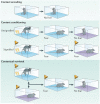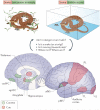The contextual brain: implications for fear conditioning, extinction and psychopathology - PubMed (original) (raw)
Review
The contextual brain: implications for fear conditioning, extinction and psychopathology
Stephen Maren et al. Nat Rev Neurosci. 2013 Jun.
Abstract
Contexts surround and imbue meaning to events; they are essential for recollecting the past, interpreting the present and anticipating the future. Indeed, the brain's capacity to contextualize information permits enormous cognitive and behavioural flexibility. Studies of Pavlovian fear conditioning and extinction in rodents and humans suggest that a neural circuit including the hippocampus, amygdala and medial prefrontal cortex is involved in the learning and memory processes that enable context-dependent behaviour. Dysfunction in this network may be involved in several forms of psychopathology, including post-traumatic stress disorder, schizophrenia and substance abuse disorders.
Figures
Figure 1. Stimulus elements, context and memory
Contexts are complex and multimodal representation that are formed by binding constituent elements into a unified representation. This figure illustrates the typical stimulus elements found in an office context and how these elements and their context might set the occasion for an aversive experience (such as getting fired) in that office. a,b | A complete representation of an office space might include not only the unique items found in an office, such as a clock, filing cabinet and desk (part a) but also the unique space in which those items are found (an office at work) and the conjunctive representation of those items in that context, such as the position of the filing cabinet, the clock on the wall next to the desk, and so on (part b). c | After they are encoded, context representations can themselves come to be associated with an event, such as getting fired in the office. d | In this case, memories of the office might come to provoke stress and anxiety by virtue of its association with a disgruntled boss and the circumstances around losing a job — indeed, the aversive memory associated with losing a job might generalize to any office-like setting.
Figure 2. Context encoding, conditioning and retrieval tasks in rodents
There are many learning and memory processes involved in acquiring and expressing information about contexts. Merely exposing animals to a novel context results in a memory of that context, a process called contextual encoding (top panel). If that context is subsequently paired with an aversive stimulus, such as an electric footshock (indicated by the lightning symbol), it will yield an association between the context and shock; this process is called context conditioning (middle panel). Context conditioning occurs with either a signalled shock, in which a conditional stimulus (CS), for example, a sound, is paired with the shock (the unconditional stimulus (US)) or with an unsignalled shock, in which the US is presented without a CS. Contexts can also acquire modulatory properties in which they set the occasion for when a CS and US are paired. For example, in a conditional discrimination task based on context, a CS is paired with the US in one context but not in another context. The context subsequently serves to retrieve the meaning of the CS in each context in which it occurs, a process termed contextual retrieval (bottom panel).
Figure 3. Brain circuits involved in cue and context processing in the human brain
The brain has separate, parallel systems for processing cues (pink) and processing contexts (green), and the context-processing system is essential for understanding the meaning of cues in a particular context. For example, a poisonous snake has a different meaning when it is encountered in the wild (where it could signal ‘danger’) than when it is seen behind glass in a zoo (where it could mean ‘interesting’). The cue-processing system includes the thalamus, amygdala, sensory cortices (the primary visual cortex (V1) and auditory cortex), posterior insula (pINS) and association areas (in the parietal lobe (PL) and temporal lobe (TL)), whereas as context processing systems involve the ventromedial prefrontal cortex (vmPFC), hippocampus, anterior insula (aINS) and subgenual anterior cingulate cortex (sgACC). There is extensive interaction between these systems insofar as contexts influence the processing of cues and the conjunctions of cues, and contexts are likely to be represented in connections between these networks.
Figure 4. Context-dependent extinction of fear in rodents
Extinction is a form of learning in which a conditional stimulus (CS) is presented alone after conditioning. Such CS-alone presentations decrease the magnitude and frequency of the learned response, and this loss of responding to the CS is context-specific. As a result, a diminished conditioned response to the CS is expressed only in the context in which the extinction occurred, but the response will return (or ‘renew’) in any other context. The figure shows the typical procedure for studying the context-dependence of extinction in rodents. In this procedure, rats are first conditioned to an auditory CS in one context (blue). Subsequently, extinction training to that CS occurs in another context (either the purple or green context), and rats are then tested in a context that is either the same or different as the one in which extinction took place. In this example, the purple context is the same context as extinction for half of the animals but a different context for the other half of the animals.
Figure 5. Context-dependence of neuronal activity in the rat amygdala
The return of fear in response to an extinguished conditional stimulus (CS) is correlated with neuronal firing in response to the CS in the amygdala in rats. a | The traces are high-pass filtered signals recorded from a single multi-unit recording wire implanted in the lateral amygdala; the sweep length is 3 s, which includes 500 ms pre- and post-tone periods and the 2-s tone CS (shaded area). Presentation of the CS occurred in either the extinction context (same) or another context (different). Neuronal responses to the CS were reduced in the extinction context but increased in the different context. b | The histogram shows the average neuronal responses to the extinguished CS in both contexts. Figure is modified, with permission, from REF. 75 © (2007) Cold Spring Harbor Laboratory Press.
Figure 6. Neural circuit for context-dependent regulation of fear memory
The context-dependence of fear memory involves a neural circuit that includes the hippocampus, the medial prefrontal cortex (specifically, the infralimbic cortex (IL) and the prelimbic cortex (PL)) and the amygdala (specifically, the basolateral amygdala (BLA), central amygdala (CEA) and intercalated (ITC) cells). The hippocampus projects directly to the BLA, and this projection may be crucial for the renewal of fear expression in response to an extinguished conditional stimulus. Indirect projections between the hippocampus and amygdala via the medial prefrontal cortex might also mediate the context-dependent expression of fear in response to an extinguished conditional stimulus. In particular, PL projections to the BLA are involved in fear renewal, whereas IL projections to ITC cells, which in turn inhibit CEA output, are involved in suppressing the expression of fear in response to an extinguished conditional stimulus.
Similar articles
- Failure of neural responses to safety cues in schizophrenia.
Holt DJ, Coombs G, Zeidan MA, Goff DC, Milad MR. Holt DJ, et al. Arch Gen Psychiatry. 2012 Sep;69(9):893-903. doi: 10.1001/archgenpsychiatry.2011.2310. Arch Gen Psychiatry. 2012. PMID: 22945619 Free PMC article. - Neural circuits and mechanisms involved in Pavlovian fear conditioning: a critical review.
Kim JJ, Jung MW. Kim JJ, et al. Neurosci Biobehav Rev. 2006;30(2):188-202. doi: 10.1016/j.neubiorev.2005.06.005. Epub 2005 Aug 24. Neurosci Biobehav Rev. 2006. PMID: 16120461 Free PMC article. Review. - Altered processing of contextual information during fear extinction in PTSD: an fMRI study.
Rougemont-Bücking A, Linnman C, Zeffiro TA, Zeidan MA, Lebron-Milad K, Rodriguez-Romaguera J, Rauch SL, Pitman RK, Milad MR. Rougemont-Bücking A, et al. CNS Neurosci Ther. 2011 Aug;17(4):227-36. doi: 10.1111/j.1755-5949.2010.00152.x. Epub 2010 Apr 16. CNS Neurosci Ther. 2011. PMID: 20406268 Free PMC article. - Nucleus reuniens mediates the extinction of contextual fear conditioning.
Ramanathan KR, Maren S. Ramanathan KR, et al. Behav Brain Res. 2019 Nov 18;374:112114. doi: 10.1016/j.bbr.2019.112114. Epub 2019 Jul 25. Behav Brain Res. 2019. PMID: 31351844 Free PMC article. - Fear conditioning: Insights into learning, memory and extinction and its relevance to clinical disorders.
Trent S, Abdullah MH, Parwana K, Valdivieso MA, Hassan Z, Müller CP. Trent S, et al. Prog Neuropsychopharmacol Biol Psychiatry. 2025 Apr 2;138:111310. doi: 10.1016/j.pnpbp.2025.111310. Epub 2025 Mar 6. Prog Neuropsychopharmacol Biol Psychiatry. 2025. PMID: 40056965 Review.
Cited by
- Behavioral, Neurophysiological, and Synaptic Impairment in a Transgenic Neuregulin1 (NRG1-IV) Murine Schizophrenia Model.
Papaleo F, Yang F, Paterson C, Palumbo S, Carr GV, Wang Y, Floyd K, Huang W, Thomas CJ, Chen J, Weinberger DR, Law AJ. Papaleo F, et al. J Neurosci. 2016 Apr 27;36(17):4859-75. doi: 10.1523/JNEUROSCI.4632-15.2016. J Neurosci. 2016. PMID: 27122041 Free PMC article. - Molecularly Defined Hippocampal Inputs Regulate Population Dynamics in the Prelimbic Cortex to Suppress Context Fear Memory Retrieval.
Hallock HL, Quillian HM 4th, Maynard KR, Mai Y, Chen HY, Hamersky GR, Shin JH, Maher BJ, Jaffe AE, Martinowich K. Hallock HL, et al. Biol Psychiatry. 2020 Oct 1;88(7):554-565. doi: 10.1016/j.biopsych.2020.04.014. Epub 2020 Apr 28. Biol Psychiatry. 2020. PMID: 32560963 Free PMC article. - Cannabidiol, among Other Cannabinoid Drugs, Modulates Prepulse Inhibition of Startle in the SHR Animal Model: Implications for Schizophrenia Pharmacotherapy.
Peres FF, Levin R, Almeida V, Zuardi AW, Hallak JE, Crippa JA, Abilio VC. Peres FF, et al. Front Pharmacol. 2016 Sep 9;7:303. doi: 10.3389/fphar.2016.00303. eCollection 2016. Front Pharmacol. 2016. PMID: 27667973 Free PMC article. Review. - Psychological Mechanisms of PTSD and Its Treatment.
Sripada RK, Rauch SA, Liberzon I. Sripada RK, et al. Curr Psychiatry Rep. 2016 Nov;18(11):99. doi: 10.1007/s11920-016-0735-9. Curr Psychiatry Rep. 2016. PMID: 27671916 Review. - Distinct ensembles of medial prefrontal cortex neurons are activated by threatening stimuli that elicit excitation vs. inhibition of movement.
Halladay LR, Blair HT. Halladay LR, et al. J Neurophysiol. 2015 Aug;114(2):793-807. doi: 10.1152/jn.00656.2014. Epub 2015 May 13. J Neurophysiol. 2015. PMID: 25972588 Free PMC article.
References
- Spear N. Retrieval of memory in animals. Psychol. Rev. 1973;80:194.
- Bouton M. Context, time, and memory retrieval in the interference paradigms of Pavlovian learning. Psychol. Bull. 1993;114:99. - PubMed
- Bouton M. Context, ambiguity, and classical conditioning. Curr. Direct. Psychol. Sci. 1994;3:53.
Publication types
MeSH terms
Grants and funding
- R24MH075999/MH/NIMH NIH HHS/United States
- R24 MH075999/MH/NIMH NIH HHS/United States
- R01 MH065961/MH/NIMH NIH HHS/United States
- R01MH071698/MH/NIMH NIH HHS/United States
- R01 MH086517/MH/NIMH NIH HHS/United States
- R01MH065961/MH/NIMH NIH HHS/United States
- R01MH086517/MH/NIMH NIH HHS/United States
LinkOut - more resources
Full Text Sources
Other Literature Sources
Medical
Miscellaneous





